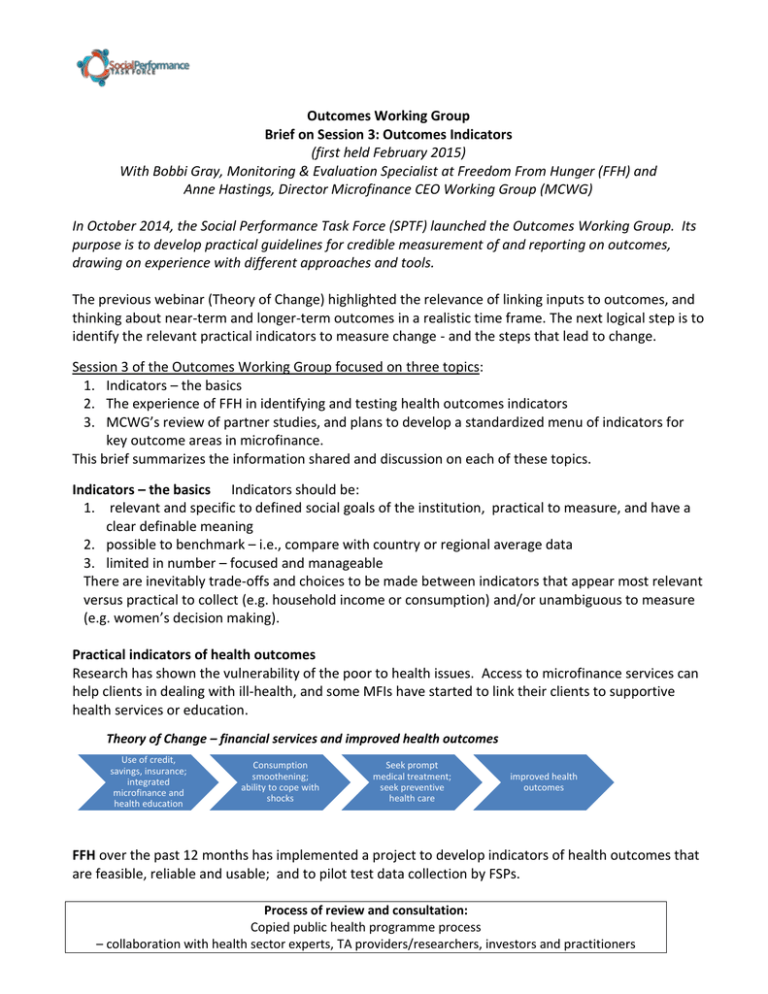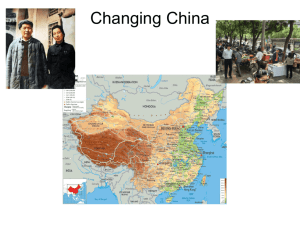Outcomes Working Group Brief on Session 3: Outcomes Indicators
advertisement

Outcomes Working Group Brief on Session 3: Outcomes Indicators (first held February 2015) With Bobbi Gray, Monitoring & Evaluation Specialist at Freedom From Hunger (FFH) and Anne Hastings, Director Microfinance CEO Working Group (MCWG) In October 2014, the Social Performance Task Force (SPTF) launched the Outcomes Working Group. Its purpose is to develop practical guidelines for credible measurement of and reporting on outcomes, drawing on experience with different approaches and tools. The previous webinar (Theory of Change) highlighted the relevance of linking inputs to outcomes, and thinking about near-term and longer-term outcomes in a realistic time frame. The next logical step is to identify the relevant practical indicators to measure change - and the steps that lead to change. Session 3 of the Outcomes Working Group focused on three topics: 1. Indicators – the basics 2. The experience of FFH in identifying and testing health outcomes indicators 3. MCWG’s review of partner studies, and plans to develop a standardized menu of indicators for key outcome areas in microfinance. This brief summarizes the information shared and discussion on each of these topics. Indicators – the basics Indicators should be: 1. relevant and specific to defined social goals of the institution, practical to measure, and have a clear definable meaning 2. possible to benchmark – i.e., compare with country or regional average data 3. limited in number – focused and manageable There are inevitably trade-offs and choices to be made between indicators that appear most relevant versus practical to collect (e.g. household income or consumption) and/or unambiguous to measure (e.g. women’s decision making). Practical indicators of health outcomes Research has shown the vulnerability of the poor to health issues. Access to microfinance services can help clients in dealing with ill-health, and some MFIs have started to link their clients to supportive health services or education. Theory of Change – financial services and improved health outcomes Use of credit, savings, insurance; integrated microfinance and health education Consumption smoothening; ability to cope with shocks Seek prompt medical treatment; seek preventive health care improved health outcomes FFH over the past 12 months has implemented a project to develop indicators of health outcomes that are feasible, reliable and usable; and to pilot test data collection by FSPs. Process of review and consultation: Copied public health programme process – collaboration with health sector experts, TA providers/researchers, investors and practitioners Criteria for selection of indicators Feasibility Usability Comparability Can be collected and analysed by Can change in short term Relevant in different contexts an FSP; reported in client Applicable with or without Can be benchmarked to other survey specific health intervention secondary data Health outcomes – areas/themes Poverty measurement, food security and nutrition, preventive health care, ability to access curative health care, water and sanitation, attitudes From a pilot with 4 FSPs (in Peru, India, The Philippines) some of the lessons are: Indicators for defined themes need to be carefully adapted to local contexts (just as PPI indicators are different in different countries whilst benchmarking against defined poverty lines) Indicators with high baseline values (>80%) are not useful to track over time Build new indicators into the FSP's existing data collection process rather than create a new system. Monitoring and understanding changes over time requires patience, reflection and iteration. Building on the FFH work – to develop a menu of outcomes indicators The MCWG is planning to develop and test a common core measurement system designed to Be cost-effectively embedded within an MFI’s operations Use industry-standard indicators and metrics (e.g. PPI) Provide affiliated MFIs with actionable client outcome data that can be tracked over time Allow MFIs the flexibility to measure changes in those client outcomes they wish to affect using a standard set of indicators for the defined outcomes Enhance ability to demonstrate & improve the benefits of Responsible Microfinance for clients Contribute to the sector’s understanding of client outcomes. The background to this is a 2014 review of 69 outcomes research studies by the 8 MCWG members and their affiliates. This revealed huge variety in indicators, methods and quality. But it also suggested certain outcome themes and common indicators, which can be adapted to local contexts. Potential themes and examples of indicators – as a starting point 1 Food security: % of households that are food insecure 2 Coping with shock: % of households that had to [make a specific adjustment or level of change] to cope with the effects of [household or community shock] 3 Economic poverty: % of households living above/below a given poverty line 4 Health: % of households with [level of access] to health care [services/supplies] 5 Assets: % of households that purchased assets in the past year 6 Social capital and empowerment: a) % of women expressing confidence in making decisions regarding [specific category]; b) % who perceive [specify benefit or value] in group participation 7 Schooling: % of [primary/secondary school age] children in the household who regularly attend school This SPTF working group is well placed to contribute to and test a ‘menu’ of outcomes indicators. The working group is open to all stakeholders: practitioners, networks, TA providers, investors, researchers, subject matter specialists – academics Contact us to share your experience and views: info@sptf.info








